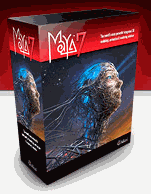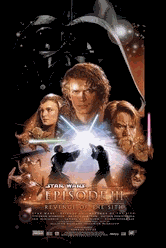Alias is the company responsible for creating
the Maya software, a 3D graphics package that has helped bring animation to
life, with stunning quality, in some of the industry's most innovative films.
Maya was the primary software used by Industrial Light and Magic (ILM) in the
recent Star Wars Episode 3: Revenge of the Sith, to create not only the
special effects, but some of the characters as well. I caught up with Bill
Coleman, Director of Global Marketing, and Robert Hoffmann, Senior Entertainment
Product Marketing Manager, to tell me some information about their company, and
find out about how Alias and Maya played a part in creating one of the most
anticipated movies of the year.
Computer Times: How did Alias get
started as a company? How has it grown and developed over the years?
Bill Coleman:
Alias began in Toronto in 1983 as a much smaller company than it is today. Since
then, many exciting things have happened.
In 1995, Wavefront Technologies of Santa Barbara
(founded in 1984) merged with Alias Research under SGI to become Alias/Wavefront.
Today, Alias still has custom-engineering offices in Santa Barbara with global
headquarters located in Toronto.
In July 2003 the company changed its name to
Alias in conjunction with its 20th anniversary celebrations.
Accel-KKR and the Ontario Teachers' Pension Plan
acquired Alias from SGI in 2004, making Alias an independent company.
In September 2004, Alias finalized an agreement
to acquire Kaydara. Kaydara was a leading developer of real-time 3D character
animation and motion editing solutions in the entertainment industry.
Alias continues to grow and develop today. By
continually improving product and service offerings available to our customers
and working to meet their ever-changing needs, we help to drive the 3D graphics
industry.
Computer Times:
What exactly is Maya, and what is unique to that
product?

Robert Hoffmann:
Maya is an Academy Award winning software package,
considered one of the most powerful integrated 3D modeling, animation and
rendering solutions available today. Based upon years of production use, Maya is
the choice of animators, technical directors and production facilities
throughout the world to deliver the highest quality results in the least amount
of time. Maya's robust feature set and industry-leading innovation (such as:
Fluid Effects, Paint Effects, etc.) provides artists the creative freedom to
bring their ideas to life.
Computer Times:
Is Maya the only technology being utilized by Alias
now, particularly in film, or are the older programs still being used alongside
it? Do animators utilize two or more software packages in tandem, when creating
the effects in a film, or stick to just one?
Robert Hoffmann:
Production pipelines utilize a variety of software and hardware to complete a
project. Many production facilities throughout the world are using Maya as the
backbone of their games, film and broadcast 3D pipeline.
As productions begin, the facilities have to
commit to a version of software and remain using it through the duration of the
production. In many cases, these productions can last several years so by the
time the production concludes, they may be using software that is several
versions behind what is currently commercially available.
Computer Times:
Which operating system does Maya use?
Robert Hoffmann:
Maya is available for multiple operating systems. Current versions of Maya can
run on any of the following operating systems:
- Windows® XP Professional or Windows ® 2000
Professional
- Red Hat Linux 9.0 and Red Hat Enterprise
Linux 3.0 WS
- SUSE Linux 9.1
- IRIX 6.5.15
- Apple® Mac® OS X 10.3 or higher
Computer Times:
Can the technology developed by Alias, particularly Maya, be purchased for home
use by consumers? Is the consumer product the very same as that used by the
professional animators, or is it a simplified version?
Robert Hoffmann:
Yes, Maya is available to consumers for purchase globally from the Alias web
site and authorized Alias resellers. There are two versions of Maya available
for purchase:
Maya Complete is the most comprehensive 3D
software solution for producing professional-quality graphics on desktop PCs or
graphics workstations. It integrates all of the foremost tools for 3D modeling,
animation and rendering within a single, production-proven workflow.
Maya Complete is the number one choice of
award-winning digital artists and animators. Its intuitive design makes it a
favorite amongst digital content creation artists and enthusiasts of all
experience levels who develop 2D and 3D artwork for film, broadcast, game
development, multimedia (print and Web) or design visualization.
The ultimate version of Maya - Maya Unlimited -
is the choice of digital artists who are looking to make their 3D projects stand
out. Maya Unlimited is typically the choice of professional animators.
Maya Unlimited includes all the functionality
found in Maya Complete, plus, it provides professional artists and animators
with additional industry leading innovations such as Maya Fluid Effects™, Maya
Cloth, Maya Hair, Maya Fur and Maya Live, for the creation of superior digital
content.
Maya Complete and Maya Unlimited are available
for Windows®, Mac OS® X and Linux®.
Computer Times:
When you provide software to a film production, do you also provide the
animators from in house, or are they hired separately by the film studio?
Robert Hoffmann:
The artists working on the projects are hired by the production facilities.
Alias supplies the software, support, training materials and many times provides
consulting to assist with certain aspects of the production/project.
Computer Times:
Do your animators and designers have mostly programming or mostly artistic
backgrounds? How many years of training are involved in creating and using the
Alias/Maya technology?
Robert Hoffmann:
In many cases the Maya developers have backgrounds in both programming and art.
We have developers at Alias with backgrounds in both areas.
The learning curve for using Maya varies from
individual to individual. Alias has done a good job with reducing this learning
curve through the release of Learning Tools, Master Classes, software
documentation and by developing the Maya software to have an intelligent and
intuitive user interface and workflow.
Computer Times:
How did the alliance between ILM and Alias come about?
Bill Coleman:
Maya has been used as a 3D software and animation package at ILM for many years;
however, with this latest production it was elevated to the role of primary
animation package.
Alias software has been helping ILM to create
visual effects for blockbuster movie projects since 1989 when they were working
on The Abyss with Power Animator.
Other notable ILM projects that have been
fuelled by Alias technology include Terminator II: Judgment Day,
Jurassic Park, The Mask, Perfect Storm, Pearl Harbor and
Star Wars Episodes: I and II. This latest installment in the
Star Wars series, however, marks the first time that ILM has used Maya software
as their primary 3D package for animating characters.
One of ILM's veteran animators, Shawn Kelly said
this about Maya and I am quoting exactly: "It was a little scary, the idea of
moving over to a whole new software but Maya is actually much easier to use than
what we were using in the past. It's so easy and so intuitive I've never wanted
to go back."
Computer Times:
What contributions did Alias/Maya make to the technology already utilized by ILM?
Did Maya supplement or replace what they were already using?

Robert Hoffmann:
Maya replaced other technology that was used in previous Star Wars films,
working alongside with Alias software. At the time of the production of
Episode III: Revenge of the Sith, ILM made the decision to have Maya as the
primary character animation package for this production and for future
productions, assisting with all 2151 CG shots.
Maya allowed the company's talented animators to
create such key scenes as the film's opening - a fast-paced, riveting space
battle over the planet Coruscant that ends with the stunning acrobatics of a
Maya-driven Obi-Wan Kenobi.
Computer Times:
What were some new features in the Maya technology that were used in Star
Wars: Episode 3 that were not employed in the first two Star Wars
films? What breakthroughs were made this time around?
Bill Coleman:
I can only say so much about ILM's workflow because I always respect each of our
customer's confidentiality but they are on record as saying that beyond
ease-of-use and the power of Maya, another key factor in making the move to Maya
was the software's customizability. They had the ability to create a custom
character interface for the animators and this let them concentrate on the
performance of the characters, so they could focus on the acting and the emotion
instead of the tools they were using.
The superb performances of ILM's digital
characters speak for themselves. They have been helping to win the film rave
reviews, and keep the theatres packed. We are psyched that we were part of their
success!
Computer Times:
Which of the Star Wars characters did Maya help to create?

Bill Coleman:
The character of Yoda appeared in 173 shots in the film and was created 100% in
Maya. The other primary character who is 100% CG is the part-droid, part-alien
General Grievous. Grievous, who appears in 84 shots, has to interact - often at
the point of a light saber - with real actors.
Because Grievous' alien visage is predominantly
sheltered behind a droid mask, he did not require the high levels of detailed
facial animation seen in Yoda. Nevertheless, Grievous has many unique, visually
impressive and sometimes "creepy" Maya-driven moves. Actually, Grievous was
modeled using a combination of Maya and Alias' StudioTools software.
Many of the key, "live" cast members - including
Ewan McGregor (Obi-Wan Kenobi), Hayden Christensen (Anakin Skywalker), Ian
McDiarmid (Supreme Chancellor Palpatine) and Christopher Lee (Count Dooku) - had
their own Maya-powered stunt doubles. These digital doubles, while never
obvious, are often used to perform daring feats and acrobatic stunts that would
be highly difficult or dangerous for live actors.
Computer Times:
Were all of the characters strictly computer generated, or were some actor
driven, like the motion capture animation used in other films this year?
Bill Coleman:
The characters were a combination of both traditional keyframe animation and
motion capture.
Computer Times:
Which are easier, projects that are entirely animated, or projects that have
live action, supplemented with graphic effects?
Robert Hoffmann:
It really depends on the project. Both have their complexities and unique
challenges.
Computer Times:
What other films is Alias most proud to have been a contributing force behind?
Was Maya the primary software used for these films?
Bill Coleman:
Alias is proud of all of its customers, and the opportunity we've had to
contribute to their success. Our contributions to the following features films
were significant over the past few years. Maya was the primary software used for
all of these blockbuster hits:
The Matrix Trilogy
- Manex/Esc
The Lord of the Rings Trilogy
- WETA Digital
Spiderman 2
- Sony Pictures Imageworks
I, Robot
- Digital Domain
Madagascar
- DreamWorks
War of the Worlds
- ILM
Computer Times:
To what other markets, apart from film, does Alias provide its technology?
Bill Coleman:
Artists in every profession use Maya software because it's the world's most
powerfully integrated 3D modeling, animation, effects, and rendering solution.
Alias technology contributes to many industries, including: digital publishing,
games, education, broadcast and design.
Computer Times:
What is the next project that Alias is working on?
Bill Coleman:
In the film and video realm, Alias is excited to be working with our customers
on upcoming feature films including:
Stealth
- Digital Domain
Harry Potter and the Goblet of Fire
Cinesite/ILM/ Moving Picture Company/Framestore
Chronicles of Narnia: The Lion, the Witch and
the Wardrobe - Sony Pictures/
Imageworks/Rythym & Hues
King Kong
- Universal Pictures/WETA
Spiderman 3
- Sony Pictures/Imageworks
Da Vinci Code
- Moving Picture Company
Computer Times:
Are there any final words you would like to say?
Bill Coleman:
Computer graphics fosters the whole idea of "suspension of disbelief." Alias is
committed to continually improving CG to make this possible in film, in video,
in broadcast, in all forms of digital creation. This is a great business to be
part of because we are really proud of the software that we create, but our
customers are what really blow us all away.
